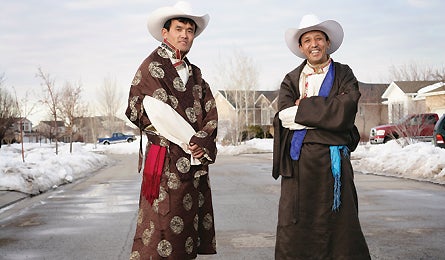The Porters' Progress

'Lhakpa Gelu and Apa Sherpa, Photo by Adam Finkle'
Why did you come to the United States?
Apa: It was actually my wife’s idea. I’ve visited the States 12 or 13 times for the Outdoor Retailer trade show in Salt Lake City, but two years ago, Yangjin, my wife, reasoned that with my record number of climbs, there wouldn’t be such a big problem with immigration. We should go to United States and get our kids a good education.
Lhakpa Gelu: School for my kids was very expensive in Kathmandu, so I was always carrying [loads] on the mountains to pay for it. My wife Pullie ran a lodge and restaurant in our hometown, Kharikhola, and we hardly had any time together. Also, many people in Nepal have no electricity, and medicine is a problem. You may have to carry a sick child one, two, maybe three days to a hospital–and not much of a hospital.
Has the adjustment been tough?
Apa: It was very difficult because of the culture and we don’t drive. For me, the language is OK–I speak a little English–but for my wife it’s more problem. She also misses her family. But Americans are a kind people. Everyone has been very helpful. And my older son, Tenzing, is driving now.
Lhakpa: Right now, life is very strange. I work so hard for so many years, so many expeditions. Now it’s like starting over on expeditions again, very hard to break in. I work all week long, and because I have second job, I don’t have off-hours or weekends.
Where do you work?
Apa: At Diamond Molding, running injection machines.
Lhakpa Gelu: I install signs for hospitals and schools, brass plaques, artistic signs, all kinds of signs. I also work a second job on weekends, I’m embarrassed to say, delivering pizzas for Pizza Hut.
What do you hope your kids will do with this opportunity?
Lhakpa Gelu: I want my children to choose their own future and not to have to climb dangerous peaks if they don’t want to.
Apa: My dream when I was young was to be a doctor and save lives. Even on the mountain, when someone has a problem, I am happy to rescue them and help them survive. That’s more important to me than the summit. So I am hoping one of my children will become doctor.
What’s the greatest challenge of suburban life?
Apa: The driving! In Nepal, we walk wherever we like to go. But here, you cannot go anywhere without driving. I thought Himalayan climbing was dangerous, but driving is much worse. And bills, bills, bills! Once kids get through school, then I hope I don’t have to work so hard.
You went to Everest in 2006 with an all-Sherpa climbing team.
Lhakpa Gelu: Yes, and it went very well. We did a fundraiser at Snowbird [a Utah ski resort] and sent $5,000 to our villages’ schools.
Apa: It was good to climb for ourselves, and not be guiding for a change. Eight of us went, and seven summited. We were strongest team on the mountain. Together, we had 55 Everest climbs between us. For us, Everest is like a family business.
Where do you see yourselves in the future?
Lhakpa Gelu: I do like installing signs, but my real job is climbing Sherpa. For years, I’ve fixed the summit ropes over the Hillary Step and the notch beyond the South Summit. I would like to be a guide, but it’s hard to find that work here. I’m also a cameraman. I filmed for Discovery Channel in 2004, and may return in 2009, guiding and shooting for them again.
Apa: I’d like to go to Hawaii someday, because Americans talk so well about it. But I’m going to begin leading trips, and we’ve started a trekking company–supersherpas.com. I’d also like to climb, but every time I go I have to argue with my wife! She’s nice and very calm, but when I say “expedition,” man, she jumps on me fast. Right now, we’re not talking about expeditions.